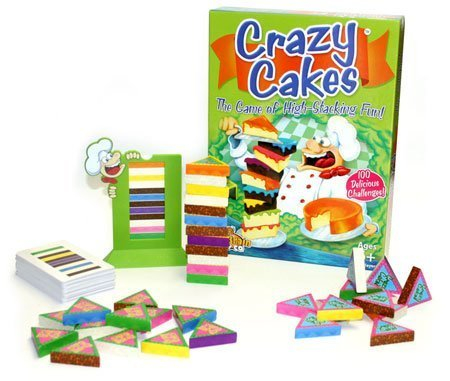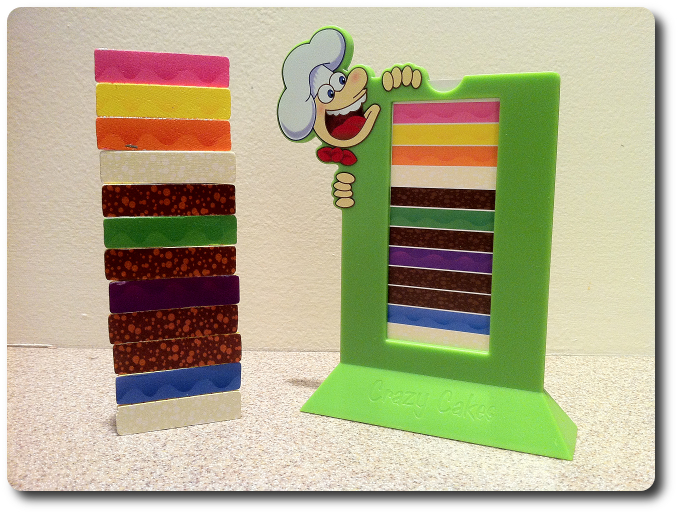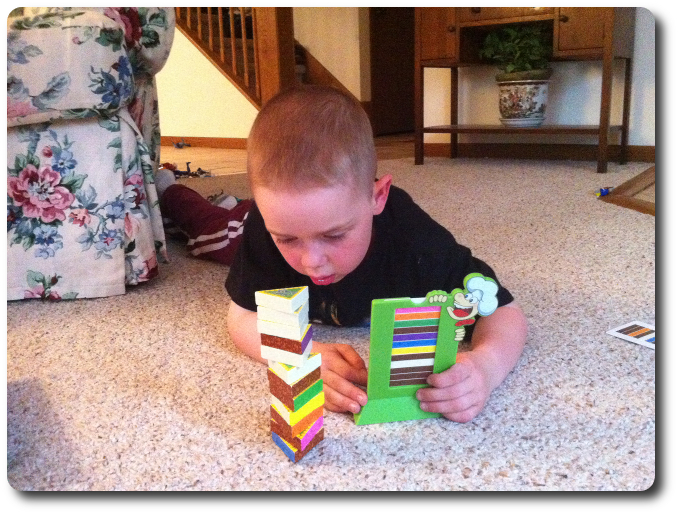
The Basics:
- For ages 5 and up (publisher suggests 6+)
- For 2 to 4 players
- Approximately 20 minutes to complete
Geek Skills:
- Logical & Critical Decision Making
- Hand/Eye Coordination & Dexterity
- Reflex & Speed
Learning Curve:
- Child – Easy
- Adult – Easy
Theme & Narrative:
- Build your cake as fast as you can, but make sure you do it right the first time!
Endorsements:
- Gamer Geek rejected!
- Parent Geek approved!
- Child Geek approved!
Overview
Cooking is more of an art form than a science, in my opinion. Anyone can follow a recipe, but each individual brings something special to the stove or to the oven that makes each dish created something unique. Seems a bit odd when you consider that the recipe suggests there is only one way to make the dish, but that’s simply not true. When it comes to this game, each player has a goal that must be achieved, but how they follow the recipe is up to them. There’s more than one way to bake a cake!
Crazy Cakes, designed by John Forte, Jr. and published by Fat Brain Toy Company, is comprised of 48 Cake pieces (wooden triangles, 12 per player), 100 Recipe cards, and 1 Recipe card holder. The Cake pieces are made of thick wood and exceedingly durable. The Recipe cards are typical for playing card thickness and the Recipe card holder is made of solid plastic. Colorful and easy to grasp, the game is perfect for the Child Geeks’ little hands and imagination.
Kitchen Set Up
To set up the game, first sort through the Cake pieces and separate them into 4 different groups by the colors on the piece’s top. There are four different color groups and each group has 12 Cake pieces. Give one complete group to each player. Any unused groups are out for the duration of the game.
Second, shuffle the Recipe cards and place them in the middle of the playing area to create the Recipe deck. Place the Recipe card holder next to the Recipe deck.
That’s it for game set up. Let’s build a cake!
Baking Up Fun
The game is played in rounds wherein every player will be racing to build a cake. The goal is to build a cake using all 12 Cake pieces and layer them so that one of the three sides of the triangular Cake stack matches the stacked colors on the Recipe card. Each of the triangular Cake pieces will have 3 colors on them. Two of the 3 colors will always be the same. For example, one Cake piece will have the colors brown, brown, and blue and another will have white, white, and pink.
At the beginning of each round, a new Recipe card will be drawn from the bottom of the deck and placed in the Recipe card holder. The Recipe card will show 12 colored lines that represent the 12 layers of the cake the players will be making. Each of the layers can be represented by one or more of the 12 Cake pieces. Players stack their Cake pieces so that the side of the stack the player is facing will match the colored layers (from bottom to top) exactly. Note that only one of the 3 sides needs to match.
Once the Recipe card is placed, all the players pick up their Cake pieces, give them a shake, and then drop them on the playing surface in front of them at the same time. This serves to randomize the Cake pieces and start the round. Then all the players attempt to build the cake using the Recipe card as a guide. Speed and accuracy are equally important here. Note that the Recipe card is double-sided with the same color pattern shown on both sides.
Ding! Cake is Done!
The players must work as quickly as possible to build their towering 12 layers of cake. Balance is necessary and careful placement of the Cake pieces. If the player rushes too fast, they risk knocking over their tower of layered goodness, forcing them to start over. Additionally, the colors they have available to them are limited. The player might find themselves with only 2 Cake pieces left that do not have the colors needed to complete the color pattern. All the player can do is go back and review their layered cake to see where they can replace different Cake pieces to free up some much-needed colors.
When the player believes they have finished building their cake, they should yell “CRAZY CAKE!” and all the player’s pause. One of the player’s opponents will now check to make certain the layered cake has been built correctly by checking if each colored bar on the Recipe card matches one of the three sides of the stacked Cake pieces. Only one of the three sides of the cake tower will be used and that side is the player’s choice.

Example of a completed cake stack that matches the Recipe card in the Recipe card holder
If the cake layers are found to be matching the Recipe card, then the player wins the round and takes the Recipe card as a trophy. If the cake layers do not match, the game play resumes (the cake was a lie), but the player is out for the round. Note that when playing with only 2 players, if one of the two players shouts “CRAZY CAKE!”, and it is found to be a lie, the player’s opponent wins the Recipe card.
Cake Boss
The game continues until 1 player has collected 10 Recipe cards. This player is truly a cake boss and gets high-fives from all the other players around the table.
To learn more about Crazy Cakes, visit the game’s web page.
Prediction
Pattern matching games are great for Child Geeks and are very useful when strengthening the core Geeks Skills that are not only used in most board, card, and dice games, but are also necessary in everyday life. They also serve as a great way to engage your children in a game that is not only entertaining, but well within their realm of understanding and ability. Crazy Cakes is such a game and it will doubtlessly be a hit with the Child Geeks. But the older the player is at the table, the less interesting Crazy Cakes will become. This is a children’s game, after all, and once you’ve mastered the basics, there is little left in the game to keep a player interested.
I don’t think the Parent Geeks will enjoy Crazy Cakes at a peer level, but I would be very surprised if they didn’t endorse it as a family game. Especially if the Parent Geeks we play the game with have younger Child Geeks. For the Gamer Geeks, I think they will pretty much hate me for putting this game in front of them. There is nothing to Crazy Cakes that would be of interest to the hardcore gamer elitist.
Teaching the game is very easy and straight forward. Match the colors on the triangles to the Recipe card as shown starting from the bottom and working your way up. Do take a moment to review the Cake pieces and make sure you inform the players that the colors are limited. Each Cake piece can represent 1 of 2 different colors. A simple 1 minute exploration of all 12 Cake piece should suffice. Other than that, there really isn’t anything else to do other than start the game.
When I introduced Crazy Cakes to my two oldest little geeks, my 8-year-old excused himself, seeing it as a “baby game”. He’s already 8-years-old, knows how to play The Settlers of Catan like a boss and thinks himself a gamer elitist, apparently. My 5-year-old, having no delusions of grandeur, was more than happy to give the game a try. After explaining the game to him, he was even more excited to play the game. He is naturally gifted at pattern matching and his love for puzzle solving is well documented by his parents. When I asked him what he thought of Crazy Cakes, he spoke very quickly and with a smile.
“This looks like a lot of fun. I’d even say the game looks delicious! See what I did there, Daddy?”~ Nyhus (age 5)
Yes, I saw what he did there. Cried a singly manly tear out of joy, too. Let’s play Crazy Cakes to determine if the game is indeed a deliciously good time or leaves a bad taste in our mouths. See what I did there, Nyhus?
Final Word
The Child Geeks we played the game with had a great time. My 8-year-old eventually gave the game a try, too, after hearing how much fun it was from his younger brother. Even though the game can be a bit frustrating at times with the Cake pieces falling down and the constant pressure to be as quick as possible, none of the Child Geeks gave us any sign that they were feeling stressed out. They talked fast, grumbled loudly, and did silly little kid curses when things weren’t going their way. Loudest of all were the groans of dismay when one of the players at the table shouted “CRAZY CAKE” and stopping the game. The players looked half-crazed at times with their eyes wide, mouths open, and sometimes breathing a bit harder than what I would considered “normal”. This game really got the Child Geeks’ blood pumping and kept them engaged from start to finish. But the game did stay a bit too long at times. Going 10 or more rounds can be very mentally exhausting. This is easily fixed, however, by simply reducing the number of Recipe cards that are necessary to win the game. All the Child Geeks voted to approve Crazy Cakes and then demanded a piece of cake afterwards.

My little geek grabs the Recipe card holder for a quick inspection before shouting “CRAZY CAKE!”
As predicted, the Parent Geeks didn’t care for the game at a peer level (although watching adults play this game can be pretty funny), but they found it to be a wonderful game for their family gaming table. They especially liked how easy the game was to teach and the subtle challenge the game provided. A number of times, Parent and Child Geeks were suddenly “stuck” when they had two pieces left to complete their cake but one of the two didn’t have the color needed. Oh, how they moaned in despair when they realized they had to go back through their cake stacks, much to the pleasure of their opponents And when the adults accidentally knocked over their cake stacks, one Parent Geek actually shouted, “Nooooooooooo!” like Darth Vader. Hilarious. All the Parent Geeks we played the game with enjoyed it and voted to give it their approval.
The Gamer Geeks had no interest in this game. They tried it, got bored with it quickly, and confirmed that this is most certainly a Child Geek’s game. They were taken aback when their cake layers suddenly couldn’t be completed and thought that was an excellent surprise. In fact, one Gamer Geek said, “Whoa! Wasn’t expecting that! Well played, Crazy Cakes. Well played.” But the surprise did nothing more than briefly amuse the Gamer Geeks and their level of enjoyment with the game was almost null with their peers. The Gamer Geeks voted to reject the game as a possible addition to their elitist gaming table.
Crazy Cakes is one of those games that you can introduce to your Child Geeks pretty early on. My 3-year-old could play the game, but not very well which leads me to believe that he’ll need to be at least 4-years-old and have a bit more gaming experience before he can play Crazy Cakes at a competitive level. My 5-year-old was beating me and he’s 1 year younger than the recommended age for the game. Ultimately, it will depend on the Child Geek, so give it a try whenever you think they are ready.
Knowing colors is not necessary, but being able to recognize them is. Obviously, the colorblind are going to have a very hard time playing this game, but even a player with no such sight limitations will have a hard time recognizing the colors on the Cake pieces if the game is not played in good lightning. Some of the colors on the Cake pieces and on the Recipe cards are very soft. In poor lighting, a player won’t be able to tell if the yellow is a white or a purple is a brown. When playing the game, make sure you have good lighting around you and I strongly suggest you play the game where the pieces will be more or less eye level. This is a sit-down kind of game, but it can also be played on hard carpets or floors just as easily.
This is a fun game, challenges even the adults, and is easy to teach to young Child Geeks. It’s also a game that can stay with your family for many years thanks to the game’s durability and simple challenge. Technically, a player could memorize the color combinations on each of the 12 Cake pieces, but that won’t help them when the game starts going. There were several rounds were players and I were able to quickly build our cakes and others where we froze because we were suddenly presented with enough pieces to finish the cake, but none of them had the right colors. You’ll be surprised how badly you DO NOT want to wreck your cake stack. And if you are foolish enough (like me) to attempt to move one of the lower Cake pieces by picking up the stack with one hand, do expect your tower of cake to fall unceremoniously about you. Laughter will be had by all and the occasional moment of sheer panic when you realize you built your cake wrong is enough to make everyone groan in disgust. But you’ll keep playing because it’s fun.
This game was given to Father Geek as a review copy. Father Geek was not paid, bribed, wined, dined, or threatened in vain hopes of influencing this review. Such is the statuesque and legendary integrity of Father Geek.



